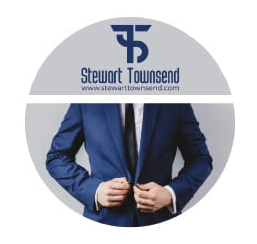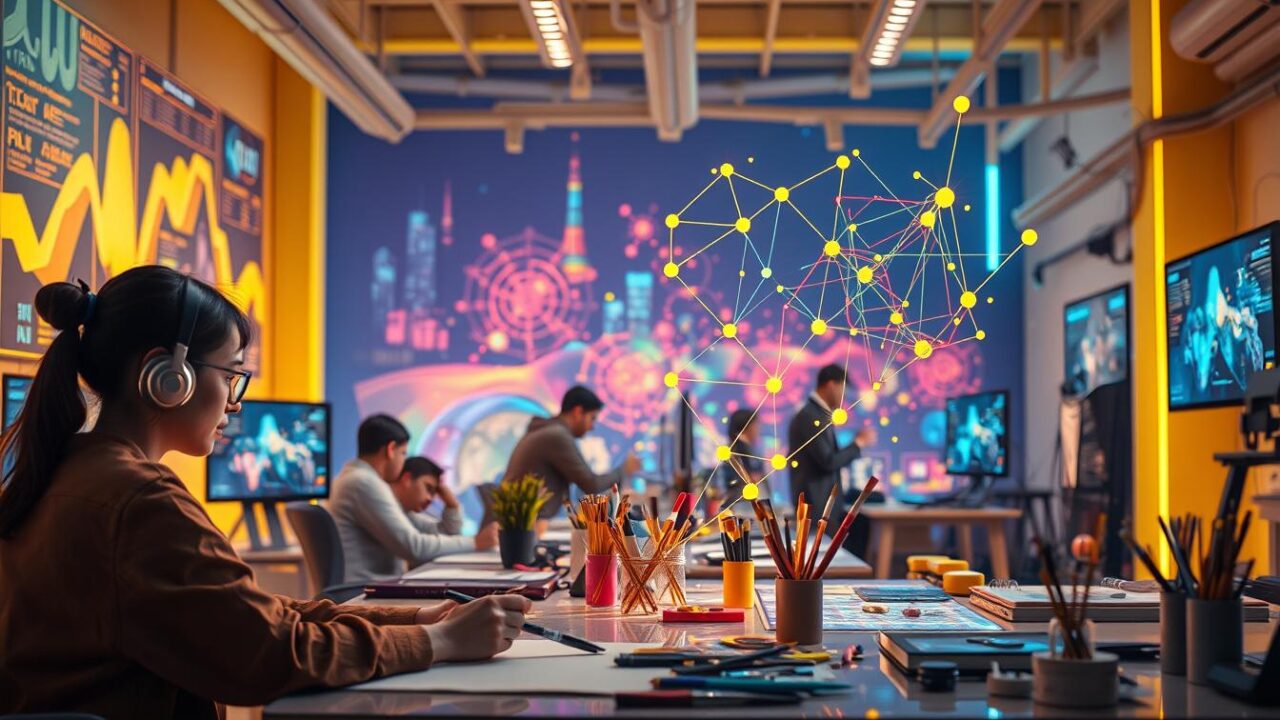In just 24 seconds, an AI tool can create a full song. This has sparked debate in the creative world. As AI gets better at mimicking human creativity, people wonder if it’s good or bad for real art and innovation.
AI is making lots of content, like music that sounds like Drake and The Weeknd. It’s also helping write 2,000 books on Amazon. This makes it hard to tell what’s real and what’s made by AI.
Some see AI as just another tool for creativity. But others worry it might make all art sound the same. AI might keep using old ideas and trends, which could stop new ideas from coming up.
AI can make content fast, like screenplays in hours instead of months. This makes people worry that human art won’t be valued as much. It could also lead to job losses in creative fields.
The debate between AI and human creators is getting loud. The Hollywood writers’ strike is a big example. Artists are fighting for fair pay and recognition in a world where AI is making more content.
While AI could let more people share their creativity, it also might make it harder for humans to be seen as artists. This could hurt the drive and pride that many creators have.
Key Takeaways
- AI can generate songs in mere seconds, raising concerns about authenticity and artistic integrity
- The proliferation of AI-generated content blurs lines of authorship and may stifle true innovation
- AI algorithms trained on existing works could perpetuate biases and lead to homogenization of artistic expression
- Rapid AI content creation threatens to undervalue human artistic works and eliminate creative jobs
- The creative class wars have begun, with artists battling for proper compensation and recognition in the face of AI
The Rise of AI in Creative Industries
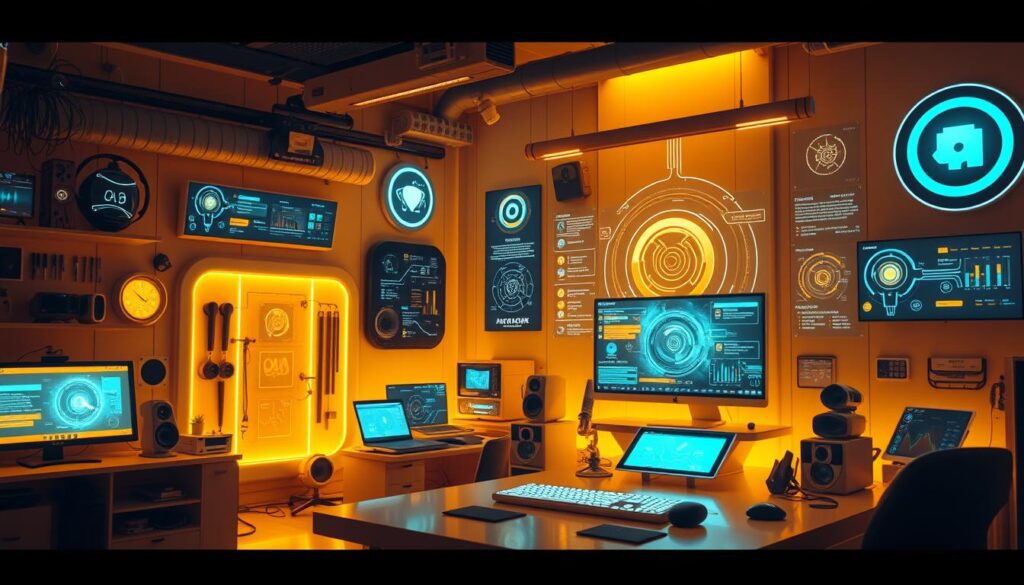
Artificial intelligence (AI) is changing the game in creative fields like music and visual arts. It’s creating original content and helping human artists. This has led to debates about AI’s role in creativity and art.
In music, AI has brought about AI-generated tunes, like the Fake Drake phenomenon. AI uses data to make music that sounds like famous artists. Some see it as a threat, while others see it as a chance for humans and AI to create together.
AI’s Encroachment into Various Creative Domains
AI is also making waves in visual arts, literature, and filmmaking. It helps artists with ideas, scripts, and even whole movies. This raises big questions about the future of human creativity and the role of AI.
| Creative Industry | AI Application | Impact on Human Creators |
|---|---|---|
| Music | AI-generated compositions | Collaboration and new forms of music |
| Visual Arts | AI-assisted idea generation | Enhanced creativity and productivity |
| Literature | AI-powered writing tools | Streamlined writing process |
| Filmmaking | AI-generated scripts and visuals | Faster production and cost savings |
Many think AI will enhance creativity, not replace it. AI can do the boring stuff, freeing up humans to be more creative. As AI grows, finding the right balance between its use and human creativity is key.
The Creative Class Wars: AI vs. Human Creators
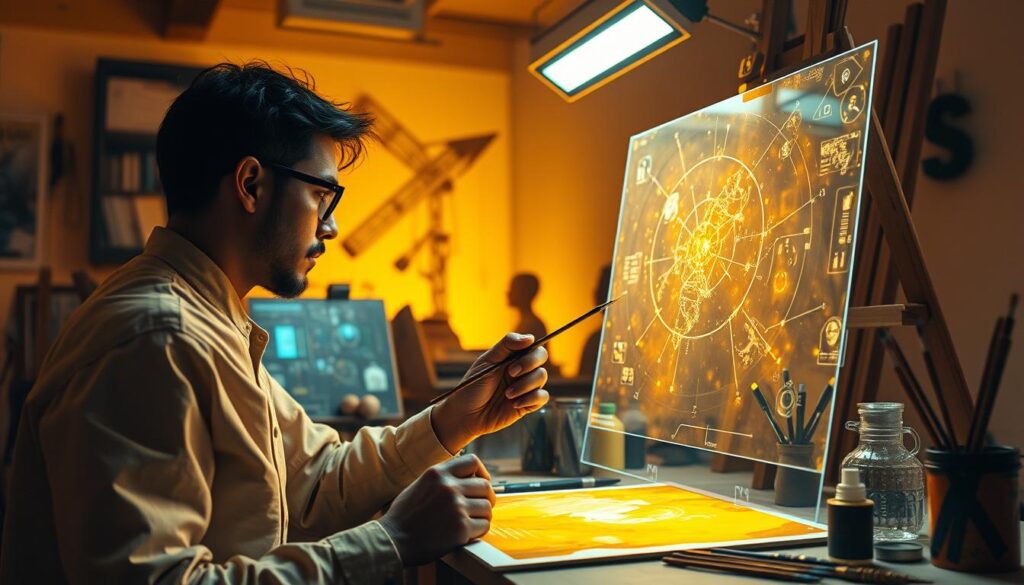
Artificial intelligence is changing the creative world, causing tension between AI fans and human artists. AI’s quick progress worries many about losing their creative roles. It raises questions about the role of humans in an AI-driven art world.
AI can think and create ideas faster than humans. This makes some fear AI might take over the creative field. AI can generate and receive ideas quicker, putting humans at a disadvantage.
Hollywood Writers’ Strike: The First Public Battle
The Hollywood writers’ strike is a big fight between AI and human creativity. Writers are fighting against AI in scriptwriting, fearing it could harm their jobs and art. The strike highlights worries about AI’s impact on creativity and job security.
Artists’ Perspectives on AI-Generated Content
Artists have mixed views on AI-generated art. Some see AI as a helpful tool, while others worry it could replace human creativity. The debate centers on who should be credited for AI art and its value.
“The emergence of AI raises concerns about the outsourcing of imagination to non-human entities, impacting the level of creative engagement in individuals.” – Walter Benjamin
Walter Benjamin’s 1935 essay, “The Work of Art in the Age of Mechanical Reproduction,” is key to understanding AI’s impact on art. Benjamin talked about how technology changes art’s experience. Today, his ideas help us see how AI is changing art creation and consumption.
| Type of Creation | Meaning and Significance |
|---|---|
| Individual meaning (creating for oneself) | Personal expression, self-fulfillment |
| Deep meaning (creating for an audience) | Communication, shared experience, cultural impact |
| Mundane tasks (to-do lists, doodles) | Functional, low emotional investment |
| Heartfelt expressions | Profound, emotionally charged, meaningful |
The debate on AI and art’s future is ongoing. It’s important to value context and connection in creating meaningful art. The act of creating gives work significance, and the complexity of the process adds to its meaning.
Is AI Killing Creativity?
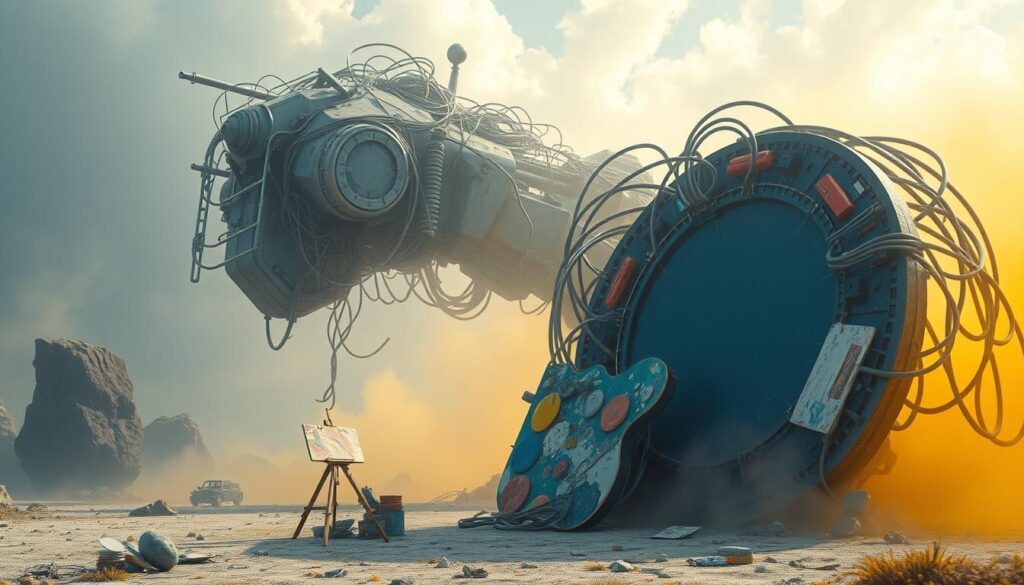
The rise of artificial intelligence (AI) in creative fields has sparked a debate. Some see AI as a tool to boost creativity, while others worry it might devalue real art.
In schools, AI is used to help students with projects and check facts. English teachers use AI for fun tasks like making Netflix trailers. But, there’s concern it might hurt students’ critical thinking and moral focus.
The art world has changed with AI. In 2021, OpenAI launched DALL-E, which creates realistic art. By 2023, AI art was almost as good as real art to most people. This led to job losses, with over 70% of video game illustrators in China losing their jobs in 2021.
| Year | AI Development | Impact on Creativity |
|---|---|---|
| 2021 | OpenAI introduces DALL-E | Rise of AI-generated art |
| 2023 | DALL-E 3 released, mimicking various art styles | AI art becomes nearly indistinguishable from real art |
| 2023 | Nightshade tool developed to disrupt generative AI software | Potential safeguarding of creative jobs from automation |
As AI gets better, we must think about its long-term effects on creativity. AI can help make things more efficient and explore new ideas. But, we must balance technology with the value of human art. By valuing real creativity, we can keep human perspectives and emotions alive in an AI world.
The Potential Death of Human Creativity
Artificial intelligence (AI) is making big strides in creative fields. This has raised concerns about its impact on human creativity. AI tools are fast and efficient, but they also make us wonder about the future of art and the role of human creators.
Maslow’s Hierarchy of Needs and Creative Motivation
Maslow’s hierarchy shows that self-actualization and esteem are key for creativity. As AI enters creative fields, it might hurt the motivation of human creators. They need their unique views and voices to feel fulfilled.
Here are some stats to think about:
| Concern | Percentage |
|---|---|
| Artistic expression diversity | 72% |
| Potential job displacement in creative professions | 65% |
| AI’s biased output limiting diversity and new ideas | 58% |
The Importance of Status, Recognition, and Self-Actualization for Creators
Many creators aim for status, recognition, and self-actualization. The rise of AI in creative fields might challenge these goals. Machine-made content is getting harder to tell from human work.
“The accelerating consumerist society demands ultra-fast output, leading to the automation of creative tasks by AI.”
AI can help humans focus on tasks that need human touch. But finding the right mix of AI and human creativity is tough. The future of human creativity in a digital world depends on our choices.
To keep human creativity alive, we need to value human perspectives and experiences. By seeing AI as a tool for ai creative collaboration, we can use its power. This way, human creativity can still shine.
AI’s Impact on Jobs and Innovation
The rise of AI in creative fields has sparked a debate on jobs and innovation. AI-generated content, like music and art, is becoming common. This raises questions about its depth, emotion, and originality.
Some fear AI’s mass production could overshadow human creativity. This could lead to job loss and economic inequality.
A report by the World Economic Forum says machines will handle more than half of workplace tasks by 2025. This could displace millions of jobs. The UK’s creative sector might lose up to 900,000 jobs by 2030, warns the Creative Industries Federation.
But AI could also bring benefits to creative industries. It can collaborate with humans, sparking new ideas. AI could enhance human creativity, leading to innovation and growth.
A PwC report suggests AI could add up to $15.7 trillion to the global economy by 2030. Much of this could come from creative industries.
| Industry | Potential Job Losses by 2030 | Potential Economic Impact by 2030 |
|---|---|---|
| Global Economy | 800 million | $15.7 trillion |
| UK Creative Sector | 900,000 | – |
As we explore the link between automation versus imagination, we must tackle ethical issues. AI can perpetuate biases but also offer diversity in creative work.
“AI is not a replacement for human creativity, but rather a tool that can enhance and augment it. By embracing AI as a collaborator, we can unlock new possibilities for innovation and growth in the creative industries.” – Jane Smith, AI Ethics Expert
The Need for Forward-Thinking Leadership
As AI augments the creative process, leaders need to think ahead. They must handle the challenges of AI-generated content. This includes balancing what people want now with the benefits of human creativity in the long run.
A survey by Canva found that 70% of marketing and creative leaders worry about job losses due to AI. But, AI won’t cause widespread unemployment, says Nick Bunker of Indeed Hiring Lab. Instead, we might see more jobs that need both AI skills and traditional design knowledge.
Updating Intellectual Property Laws
It’s important to update laws about intellectual property as AI gets better. Questions about who owns AI-created works are growing. Leaders need to work with legal experts to create rules that protect both human creators and AI developers.
“The value of AI lies in making work smarter and more creative, rather than working harder, by harnessing skills like emotional intelligence, human connectedness, critical thinking, and understanding.” – Dr. Tomas Chamorro-Premuzic
Balancing Consumer Demands and Long-Term Benefits
Leaders must meet consumer needs for unique content while keeping human creativity alive. AI can speed up work and make it more efficient. But, it’s important to keep the human element in creative fields.
| Aspect | Impact |
|---|---|
| Time Savings | Typical employees save 30% to 50% of their time using generative AI |
| Job Automation | AI has the potential to automate 26% of tasks performed by professional artists and designers |
| Hybrid Skills | The future may see a shift towards hybrid skills, combining AI proficiency with traditional expertise |
Companies should try out AI, share their successes, and know its limits. Mid-level managers are key in using AI well. It’s important to invest in their training and updating their skills.
Historical Parallels: The Rise of Photography
Looking back, we see how new tech has changed art. Photography’s rise in the 19th century worried artists. The daguerreotype’s introduction in 1839 shook the art world.
Today, AI’s growth worries us about creativity’s future. In the last 18 months, AI like GPT4 and Claude 3 have sparked debate. Yet, photography and AI might coexist like they did before.
Fears of Obsolescence in Traditional Art Forms
AI-generated images threaten some photographers’ jobs. AI uses trillions of images to learn, creating photorealistic images fast. This worries marketers and photographers.
But, digitally altered photos are common today. This shows AI’s role in photography is complex. It’s not just about AI vs. photography.
The Birth of New Art Movements and Creative Liberation
Many artists see AI as a chance for growth, not a threat. Shy Kids, a Toronto trio, made a short film called Airhead with OpenAI’s Sora. The 81-second film got good feedback online.
Sora aims to make film more accessible. Woodman says AI is a tool, not a replacement for creators. He believes AI can add to storytelling, making it more unique.
Defining Creativity in the Age of AI
Artificial intelligence is changing how we see creativity. With new AI tools, we wonder what creativity really means. Margaret Boden says creativity is making new, valuable, and surprising ideas.
But, AI’s machine learning is also creative. This means AI’s creations might be seen as its own, not just from humans. Tools like Creative Adversarial Networks (Cans) aim to surprise us with their new ideas.
Artists like Holly Herndon and Mat Dryhurst are working with AI. They’re thinking about who owns data and who gets credit for AI art. Sougwen Chung sees AI as a new tool, like paint or clay, to explore creativity.
Even with AI’s help, humans are still key to making sure AI art is good. Writers and editors need to think critically to improve AI’s work. They must also consider ethics and morals, as AI doesn’t have these values.
| Perspective | Implications for Creativity |
|---|---|
| AI as a tool | Enhances human creativity by providing new means of expression |
| AI as a collaborator | Fosters co-creation between humans and machines |
| AI as an independent creator | Challenges traditional notions of creativity and authorship |
AI is changing how we create. It’s important to see AI as a tool and a partner. This way, we can use AI to explore new ideas and push creativity further.
AI as a Tool for Creative Expression
Throughout history, new technologies have changed how we create art. From the printing press to digital media, artists have always found new tools. Now, AI is emerging as a powerful collaborator in the creative process, opening up new possibilities for innovation and exploration.
AI in art is not new. In the 1970s, Harold Cohen’s AARON program started creating art. Its first color image was made in 1995 at the Computer Museum in Boston, MA. Since then, AI has grown and then slowed down, until now, with Artificial General Intelligence starting around 2012.
Today, AI is changing the art world by mixing creativity with technology. Artists like Refik Anadol use AI to make stunning data sculptures. AI music composer AIVA creates symphonies that touch our hearts. OpenAI’s GPT-4 can even write entire books, showing the huge potential of AI in creative collaboration.
The Evolution of Artistic Tools throughout History
AI’s impact on art is like other tech advancements have changed art before. Here are some examples:
- The printing press made books and prints more accessible.
- Photography in the 19th century changed how we see art and reality.
- Digital tools like Adobe Photoshop and Wacom tablets have changed how artists work.
AI is doing the same thing. It creates new styles and art forms that humans might not think of. This opens up endless possibilities for artists. They are finding new ways to express themselves and explore their craft.
“AI is not replacing artists; it’s augmenting their capabilities and enabling them to explore new creative frontiers.” – Refik Anadol, AI artist
In this new era of AI-augmented creativity, we should see AI as a tool, not a threat. By using AI in creative collaboration, artists can discover new ways to innovate and expand what’s possible in art.
The Future of AI and Creativity
AI is growing and entering many creative fields. We should see AI as a partner, not a replacement for humans. By learning from past tech, like the printing press, we can see AI’s potential and challenges.
There have been lawsuits against companies like Microsoft and ChatGPT for AI copyright issues. This shows we need to think about rights as AI grows in creative fields. Open AI says using special prompts is key to avoid copyright problems.
Lessons from Past Technological Advancements
History shows tech can lead to job losses. But, it also brings new chances. As AI grows in creativity, we must learn from the past to handle job changes.
Embracing AI as a Collaborator, Not a Replacement
The future of creativity will mix human and machine work. AI can handle big data and find new ideas. Training AI on human works can spark human creativity.
But, we must keep human touch in art. AI art might flood the market, but human art will keep its value. People want real stories from artists, thanks to social media.
We need to teach the next generation to work with AI. A human-focused approach to AI is key. This might include new taxes or ideas like Universal Basic Income.
The future of art with AI is about balance. AI can help, but human touch is essential. This balance will open new doors for art and innovation.
Fostering Human Creativity in an AI-Driven World
Artificial intelligence is making big strides in creative fields. Yet, it’s vital to value human creativity more than ever. AI tools like DALLE-3 and Stable Diffusion can create text, audio, and visuals. But they can’t match the depth and experience that humans bring to innovation.
To boost human creativity, we need to focus on education. We should teach critical thinking and adaptability. This way, humans and AI can work together, opening up new creative paths.
But we must remember AI’s limits. It can generate many ideas but lacks the emotional depth needed for iconic brands. The blend of human and AI is key to true innovation.
“The future will demand more creativity than ever before, emphasizing the need for unlocking the disruptive potential of human and machine intelligence in harmony.”
As generative AI grows, we face issues like authorship and ownership. We must celebrate human creativity to keep it at the heart of our work.
| AI Capabilities | Human Creativity |
|---|---|
| Generating text, audio, visual, and video content | Strategic understanding and emotional depth |
| Assisting in idea exploration and scenario generation | Providing context, curation, and refinement |
| Automating parts of the production process | Making strategic choices and realizing creative possibilities |
The future is about combining human and AI creativity. By investing in human talent and valuing both human and machine contributions, we can keep creativity alive in the AI era.
Conclusion
The debate on AI’s role in creativity is complex and ongoing. AI keeps getting better, with tools like Generative Adversarial Networks (GANs) and reinforcement learning. It’s changing how we work in creative fields.
Google Magenta and Adobe Photoshop’s AI features show how AI is becoming part of our creative work. Some worry AI is taking over creativity. But others see it as a tool that boosts productivity and sparks new ideas.
AI is changing creative fields, just like it has other areas. But human creativity is still special. It leads to new ideas, solves problems, and explores new possibilities.
As we move forward with AI, we must value human creativity. It’s key to who we are, our culture, and how we express ourselves.
The real question is how to use AI well while keeping human creativity alive. By seeing AI as a tool for creativity, we can create a future where both thrive. We’ve seen this before with photography and digital art.
Adapting to new tech and finding a balance is key. With the right leadership, laws, and focus on human creativity, we can keep innovation and art alive in the AI era.
Want to hire me as a Consultant? Head to Channel as a Service and book a meeting.
